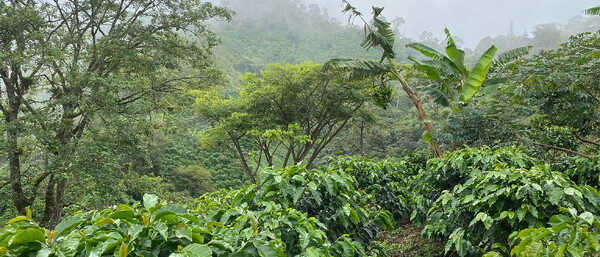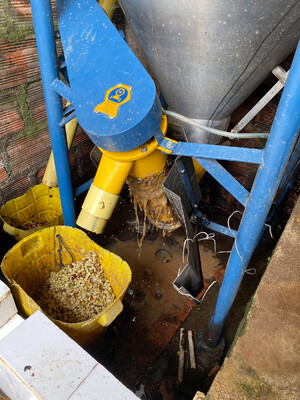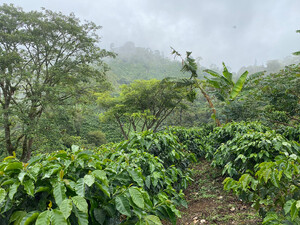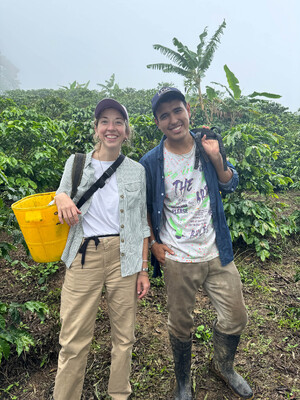
The Tchibo coffee country programme (10)
Dear readers,
Today I'm reporting from Colombia, to be more precise from Huila and Tolima. With a production of around 3.2 million bags (60kg of green coffee) in Huila and around 1.6 million bags in Tolima, the two southern states are now among the most important and productive coffee growing regions in Colombia. While in the classic “Eje Cafetera” (Antioquia, Caldas, Risaralda, Quindio and Valle de Cauca) the coffee production is partially declining and farmers are switching to other products - such as avocado or limes - producers in the southern parts of the country are looking more optimistic towards the coffee business. Probably, this is also because this year's main harvest (from October to December) in Huila and Tolima is good and coffee prices are at a high level. For many farmers, this is a kind of compensation for the last two difficult years with extreme rainfalls and long periods of drought, during which many farmers were barely able to cover their production costs.
To give you a bit of context: As you know, in our CRC team, we are working on the roll-out of the Tchibo coffee program in our key countries of origin. So also in Colombia.
Together with our long-standing business partner and exporter “Expocafé” and four cooperatives, we are working on a project to increase the productivity of coffee farmers and to make the wet processing (the “washing” of the coffee) more environmentally friendly, mainly by reducing water consumption and water pollution. In Colombia it is common for producers to wash and dry the collected coffee cherries directly on the farm and then sell the parchment. Depending on the infrastructure and process, the water consumption for the production of one kilogram of parchment can be between one and 20 liters of water. Among other things, both we and the cooperatives are making financial resources available for the transition to more efficient systems. But of course that alone is not enough! We ensure that the farmers receive regular support from agronomists and organize larger trainings in which the exchange between farmers is also encouraged. In addition, we collect soil samples and create plans to fertilize the coffee trees based on the results. In addition to adopting good farming practices, the correct use of fertilizers is an important factor in farm productivity.
To give you a better feeling for what this actually means, I would like to introduce you to two producers: William Jr. and Doña Marina.
William is 26 years old and lives with his father on a farm about 1.5 hours from Chaparral in the mountains of Tolima. We have to walk the last few meters. The farm cannot be reached by car. Nearby there is a school, a small chapel and a few shops where you can buy essentials. William and his father own around 5 hectares of land, where mainly coffee is grown. Only a few avocado, banana and lime trees as well as sugar cane can be seen on the steep slopes. The fruits of the trees are for own consumption and for the coffee pickers. Shade trees are only few and agroforestry systems are not widespread in this region of Colombia. Some coffee lots are under renovation. That means: The old, no longer productive coffee trees were cut down and new ones were just planted. Regular renewal of individual lots is one of the practices that is intended to help keep production continuously at a high and consistent level. William grows the coffee seedlings himself in his own nursery. He explains what's important: Only healthy plants with stable, downward-grown roots are planted as soon as the stem of the plant becomes woody. William's farm already has a water-saving machine that removes the pulp and sugar layer. In comparison to the classic process, only around 1 liter of water is used to produce one kilogram of parchment because the sugar layer is removed mechanically and no water-intensive fermentation process takes place. However, William and his father also report challenges. It is not so easy to find pickers and the prices for labor and fertilizer are rising. In recent years, due to heavy rain, there have also been small landslides that have swept away a few trees. So there are still a couple of things that the two of them want to improve in future.
While William cannot imagine leaving the farma, Doña Marina's (adult) children all now live in the city. She manages the farm alone, occasionally getting help from her brother, who also grows a few hectares of coffee next door. Marina's farm is about 45 minutes by car from Garzón (Huila), is about 2.5 hectares in size and, in addition to coffee, she has a small vegetable garden right in front of her house, where the property doesn't yet slope completely steeply. Many of the coffee plants have lost a number of leaves during the intense and long dry season. This can particularly affect the next harvest, as the trees will initially produce new leaves - at the expense of flowering.
Marina also processes the coffee herself (like 93% of Colombian farmers do). She uses the traditional method: the outer shell and pulp are removed by machine, then the coffee beans are fermented in water tanks and then washed again to remove the sugar layer. Up to 20 liters of water are used per kilogram of parchment. Since bad weather damaged her drying bed, Marina currently has to sell the parchment as wet parchment, for which she receives a significantly lower price. Marina has at least already found a solution for another challenge, namely transporting the parchment to the next buying station in Garzón. There is some form of public transport in the area. This means that jeeps regularly pass by their house. She knows some of the drivers well. They take their coffee with them to Garzón and hand it in at the cooperative there. The cooperative then transfers the money directly to Marina's cell phone.
During the trip to Colombia, I met many more coffee farmers and once again it was obvious: There is not “the one” coffee farmer. The range is huge! In addition to Marina and William, there is Daniela, for example, who set up her own specialty business at the age of 29. She has her own team of pickers and manages various microlots (Geisha, Yellow Burbon, Red Java…) on the large, family-run farm in Trujillo (Valle de Cauca). Their coffees are available in the hip cafés of Bogotá and are sold all over the world. But there is also the indigenous family who grow coffee, bananas and avocados on less than a hectare of land, have a small fish pond and a few chickens. Or the farmer who tries to generate additional income through beekeeping and selling honey.
What should be made clear here: All these people, all these (coffee) farmers, have very different stories, requirements, challenges, needs and wishes. It is not enough to specify a standard and thus justify sustainability in the supply chain. The support must address the individual challenges so that we can create a long-term impact. That's exactly what we want to achieve in Colombia, but of course also in our other countries of origin! With our Tchibo coffee program, we are strengthening our long-term partnerships and supporting small farmers based on their needs. Increasing productivity and implementing efficient and environmentally friendly practices as well as infrastructure are important measures that lead to improving farmers' income and living conditions. With our program in Colombia, we are also strengthening the cooperatives, which play an important role for the entire community in the relevant regions. The cooperatives not only support coffee farmers all year round with technical expertise, but also ensure access to fertilizers, financing and marketing. They run hotels, childcare centers and cafés that significantly improve the quality of life in places like Chaparral or Garzón.
Tchibo has already implemented projects in Colombia in the past, in the Antioquia, Nariño and Sierra Nevada regions. Our export partners still work with the producers and our colleagues still buy coffee in the relevant regions.
Kind regards from Colombia,
Lena


